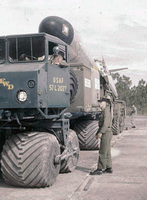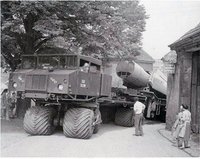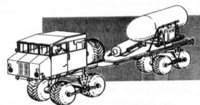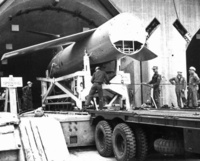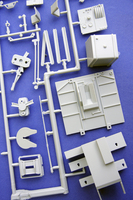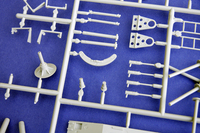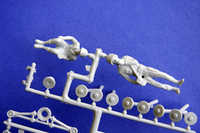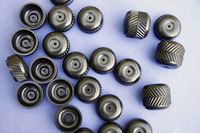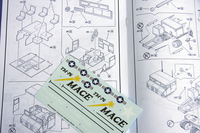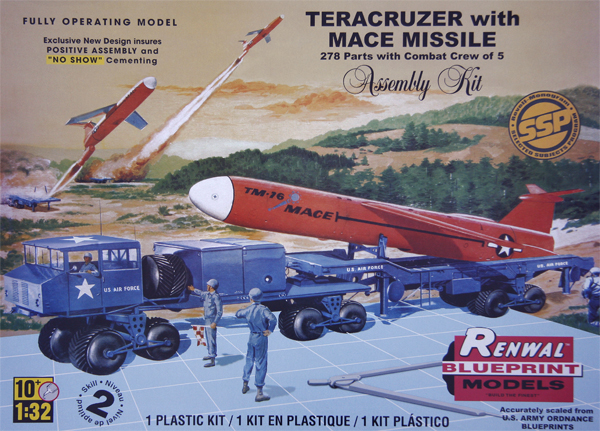
Revell 1/32 Renwal Teracruzer and Mace Missile
By Mike Whye
With a heavy thump similar to the 1950s-era Renwal Atomic Cannon kit that landed in my lap a few months ago, Revell has released another kit from the same era--the 1/32 Renwal Teracruzer with Mace Missile. Yup, it's another big kit in a big box. This box measures about 16.5 x 22 inches x 4.5 inches--I think it could contain four Monogram 1/72 B-52 kits.
First, a history of the real Mace
After WWII, the U.S. wanted surface-to-surface tactical missiles that carried conventional or nuclear warheads. Following the studies done on the captured German rockets, the Glenn Martin Company developed the B-61 Matador which was also known as the TM-61A or MGM-1 (Mobile Ground Missile). Basically a super-sized follow-on to the German V-1, the Matador could receive in-flight instructions radioed to it from a command station. It was also designed to be launched from a mobile unit.
Further development of the Matador led to the creation of the TM-61B; that was renamed as a new missile, the Mace, which received the official designation of TM-76 (Tactical Missile). The Mace - at 44 feet - was longer than the Matador - at about 29 feet - although it had a narrower wingspan (23 feet versus 38 feet) but it weighed 18,000 pounds versus 12,000 pounds for the Matador.
The Mace was also easily distinguished from the Matador by its rounded nose and wings mounted at the top of the fuselage. The Mace's wings could be folded back alongside the fuselage like some WWII U.S. Navy carrier aircraft so the entire missile could be carried by just one transporter.
Although the Mace may look like a rocket at first glance, it used the air-breathing Allison J33-A41 turbo-jet which produced 5,200 pounds of thrust. The air intake was on the underside of the fuselage near the wings. Because it used a jet engine that was also used on P-80s, T-33s and other aircraft, the Mace could be serviced by jet engine mechanics rather than rocket engine specialists. The Matador had a range of 650 miles whereas the first version of the Mace could fly up to 800 miles after launch. The Matador's W-5 warhead had a yield up to 70 kilotons whereas the Mk-28 warhead carried by the Mace had a yield up to nearly 2 megatons.
The first operational version of the Mace, which was also designed and built by Martin, was also called the MGM-13A, or Mace A. This was launched from a mobile trailer, also called the translauncher, which was pulled by a tractor unit called the Teracruzer. A nine-man crew needed at least 43 minutes to prepare the Mace for firing at a remote location.
The Mace's guidance system compared a series of filmstrips to radar images of the ground below and corrected the missile's flight path until the radar image matched the film images. The military called it a "fire and forget" missile which was impervious to enemy radio signals. However, over featureless bodies of water, this guidance system was said by some to be worthless.
For several reasons, the portable launch system was abandoned after about 18 months, and the Mace A missiles were then based at fixed sites on their launch trailers in multiples of four until hardened launch facilities could be built for the later version of the Mace--the Mace B which was also called the CGM-13 (Container Ground Missile).
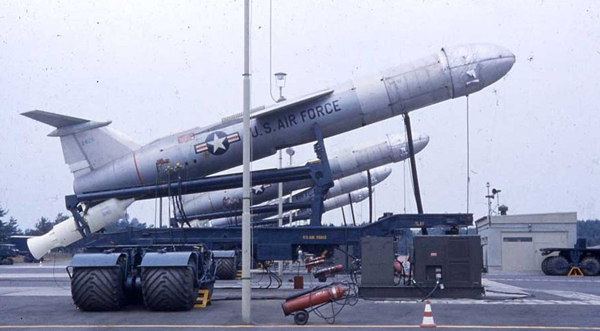
Identical in size to the Mace A, the Mace B had a 1,400-mile range and used a new guidance system which had five gyros that required using a known fixed point at launch. Thus, the Mace B had to be fired from fixed hardened sites although some were fired from translaunchers during tests done in the U.S. which might explain why a Mace B is on a translauncher at the U.S. Air Force Weapons Museum at Eglin AFB in Florida.
First launched in 1956, Mace missiles were operational in West Germany in 1959 and were later deployed in South Korea and Okinawa. With the introduction of the Mace B in 1961, the Mace A's were phased out leaving only the Mace B's on duty in Europe until 1969 when they were retired in favor of the U.S. Army's MGM-31A Pershing missile despite the Pershing having only half the range of the Mace B (for those wondering why the Army also had ground-to-ground missiles when the Air Force did too, a 1956 ruling by the Secretary of Defense stated that the Army's missiles could have a maximum range of 200 miles while those that went further were to be controlled by the Air Force).
Mace B's in Japan were removed from duty in 1971.
About 1,200 Mace missiles were manufactured at a cost of $452,000 each, and some continued serving the U.S. until May 1977 when the last one was launched as an MQM13, a target drone. One drone withstood hits by Sidewinder missiles and 20mm cannon fire and continued on from the test range to fly over Cuba before disappearing when its fuel supply ran out. Somehow, nothing came of this incident diplomatically. Much confusion has arisen over the nomenclature of the Mace missiles because their official designations were changed several times during their lifetimes.
For clarification as to what Mace was what, visit this page at the Directory of U.S. Military Rockets and Missiles.
The Real Teracruzer
Made by FWD Corp. of Clintonville, Wisconsin, each Teracruzer cost about $36,000. Top speed was 25 mph. A Teracruzer pulled a TM-61B in President Dwight Eisenhower's second inaugural parade in 1957 (a picture shows "Matador" painted on the missile's fuselage but that was before the TM-61B was renamed as the Mace).
The above information about the real Mace missiles and the Teracruzer came from "U.S. Air Force Ground Launched Cruise Missiles," a 1992 report written by Lt. Col. Randall Lanning, USAF; and "U.S. Air Force Tactical Missiles, 1949-1969 The Pioneers," a book written by George Mindling and Robert Bolton.
The Kit
Did I mention this is a big kit? If you're expecting this to be a kit from the 1950s and early 1960s with a half-dozen so-so-formed pieces that glue together in 45 seconds, you're wrong. As said on the box top, the kit has 278 pieces and a 20-page instruction book.This kit actually has three sub-kits: the Mace missile which measures 15.5 inches long when assembled; six sprues holding pieces for the Teracruzer cab with its fuel/power units; and two sprues with pieces to build the launcher supporting the missile. Each sub-kit is in its own plastic bag with its open end folded over and taped shut. By the time I opened the box, a few pieces had already separated from the sprues so it might be wise to keep each sub-kit in its own bag until you're ready to assemble it.
This kit has no clear plastic parts. That's quite a shortcoming for a kit that has nine windows in the driver's cab. So get out your thin sheet of clear plastic and be ready to cut out the windows you need.This kit's pieces have ID numbers on the sprues and pieces and are very easy to read. The only area that I see for concern is the interior of the cab doors which have both ejection pin marks and ID numbers; you can sand those away easily but there's no detail on the door interiors so either leave them closed or just slightly open so the lack of interior is not seen.
The pieces are crisp and formed very well in medium-gray styrene. The only exceptions are the figures, each of which has a very visible sink hole and has overly-soft contours (think of figures made of soft putty).Overall, all other pieces look fine, have no sinkholes or ejector pin marks that will show once the kit is finished except for those on the inside of the cab doors as I noted a few moments ago. I saw only a couple bits of flash.
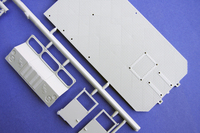
The kit also has seemingly countless wheel halves to form the twelve tires under the vehicles plus one spare carried behind the cab.
Instructions and Decals
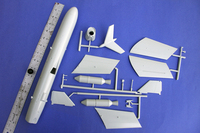
The decals, which are few, look fine. The decals for the missile appear to represent the markings of a test missile with white letters and stars and bars to be displayed atop each wing and on the aft fuselage.
To display an operational Mace A, you'll find a variety of markings on photos found on the Internet-- white letters or black letters for "U.S. Air Force" on the fuselage; stars and bars and "USAF" on both upper and lower wings as typically found on most USAF aircraft of that period; and black tail numbers and red turbine stripes (neither of which are in the kit's decals). Sometimes the stars and bars on the fuselages of the real missiles were are aft of the wings and other times they're ahead of the wings.
The Kit and Reality
As is obvious, the kit allows you to build a complete Mace being carried by its Teracruzer cab and translauncher. The kit states to paint the Mace missile orange but if you study photos of the real Mace missiles, you'll see you have a some choices. Orange is fine for test versions of the missile. Or you can create an operational Mace A by painting the body aluminum and its nose cap olive drab. Or you can create another test missile, a Mace B, which was sometimes fired from launch trailers at Cape Canaveral (now the Kennedy Space Center) so those would have been overall aluminum.The kit's tires represent reality fairly at best; compare them to photos of the real ones and you'll see each raised ridge on the tire has a small dog leg near where the tire halves meet whereas the tread on the left and right halves of the kit's tires meet as a simple V at a middle seam.
On most color photos of real Teracruzers and translaunchers, the lettering is yellow, not white which is what the decals are; however, a launch trailer I photographed last year at the U.S. Air Force Weapons Museum at Eglin AFB, Florida, has white lettering. Also, on two places on the front of the cab, the logo of the FWD Company is painted yellow, like all other lettering on the vehicles--the kit has no decals for this marking although the FWD logo is raised so at least you can paint them.
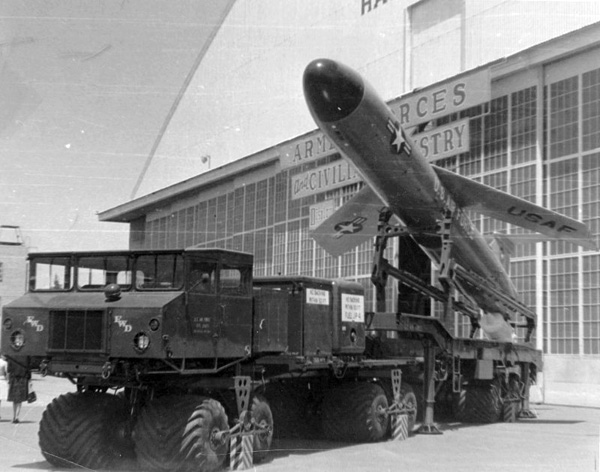
Note that the missile's engine exhaust port and the tail end of the booster rocket's nozzle are not sealed visibly, thus allowing someone to look up into those items. You'll need to do some work to visibly seal off these areas.
The kit can be displayed in various ways. 1) As though the entire assembly is at a launch site (remember, during transport, the front quarter of the missile was carried on another vehicle and mated to the missile just before launch) with the missile in the up or down position; 2) with the missile in a upraised launch position on the trailer with the Teracruzer out of the way, as the launch crews did when launching the Mace; 3) with the Mace's wings deployed or folded; and 4) with the translauncher's jacks retracted or extended.
Summary
Although there are some faults - which I'd regard as minor faults - with this kit, it should build up into a great representation of a Mace missile being carried on its translauncher and pulled by a Teracruzer. When complete, I'm guessing this kit measures about 20 inches from the front to back.
Its suggested retail price is $69.95 and our thanks to Revell for sending the review sample.

